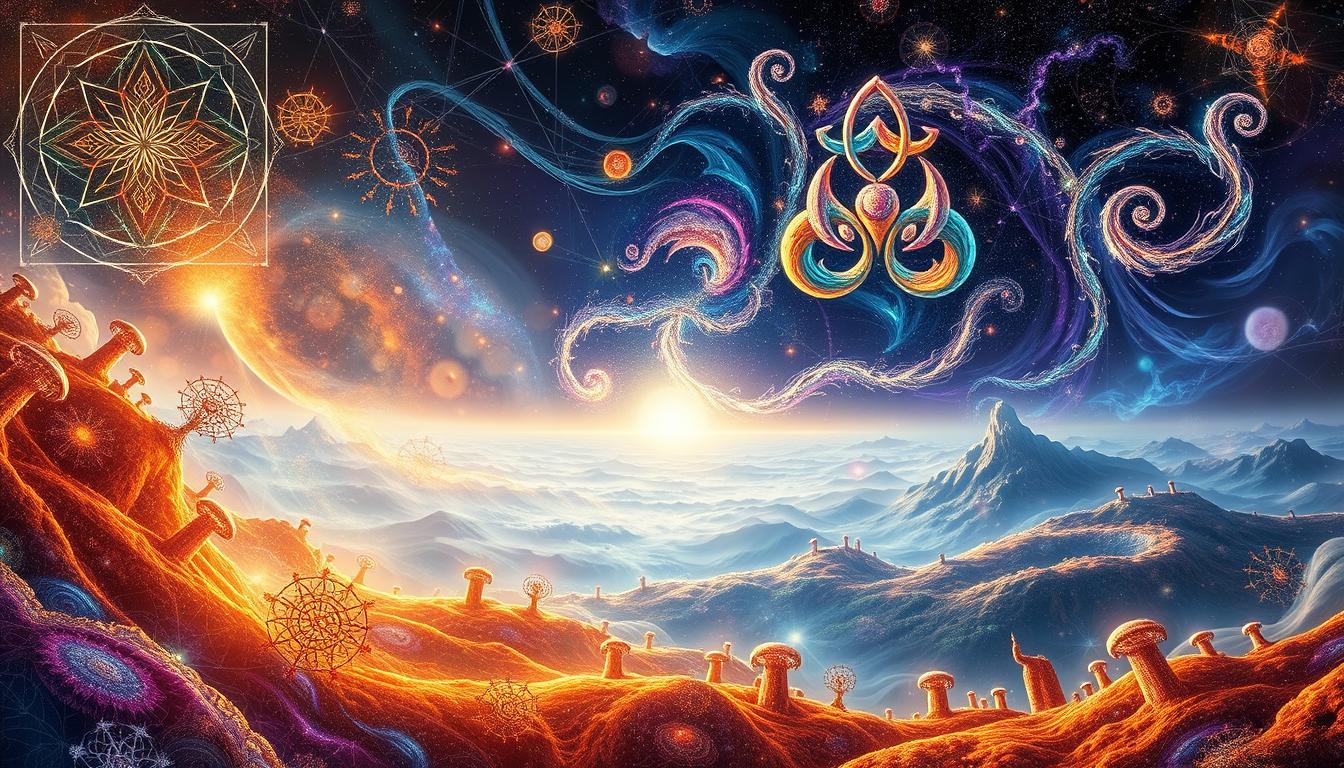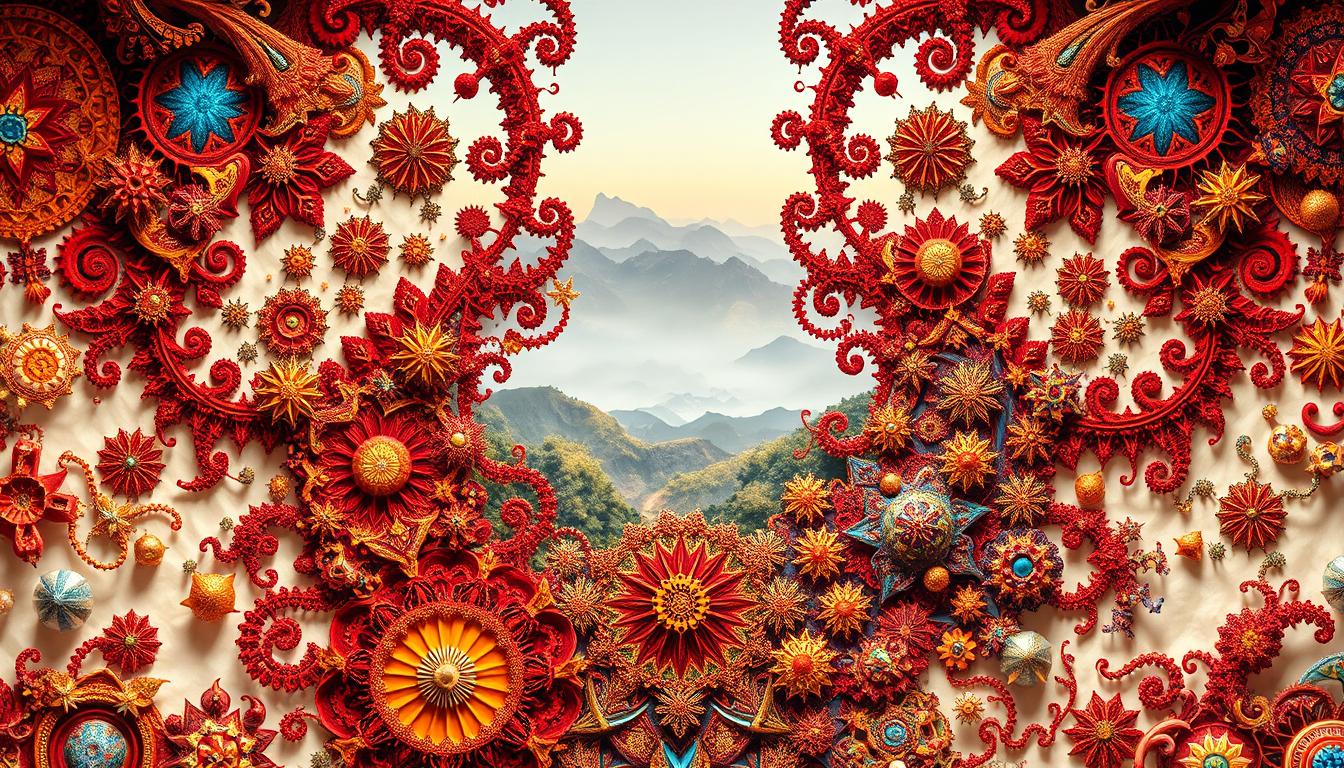Benoit Mandelbrot’s work and indigenous patterns show how nature uses geometry. He was famous for his work on fractals, showing the repeating patterns in nature. These studies suggest our universe is organized, not chaotic. This article looks at how fractals in indigenous patterns help us see nature and art from different cultures in new ways.
Understanding Fractals and Their Significance
Fractals are defined as complex patterns. They look similar at different scales. We see these endless structures in nature—from huge mountains to tiny tree branches. Fractal geometry combines simplicity and complexity through math, making it interesting in both science and art.
Fractals are more than just pretty. They show patterns in nature that are hard to see right away. Benoit Mandelbrot showed how fractals help us understand natural shapes in his work, “The Fractal Geometry of Nature.” By studying fractals, scientists can find order in chaos and complexity.

Studying fractal geometry changes how we see nature. It also touches areas like math, physics, and computer science. Fractals bring these fields together, showing how important they are for new discoveries.
What Are Indigenous Patterns?
Indigenous patterns are a rich mix of cultural stories, often with repeating and geometric shapes. These designs are found on many cultural items, artworks, and landscapes. They show the unique identities of different indigenous groups. These patterns draw from nature, featuring shapes seen in plants, animals, and the earth.
Indigenous patterns are more than just pretty designs. They are a way to tell stories and keep traditions alive. They share thoughts on ancestry, spirituality, and the bond with the earth. Through these detailed patterns, indigenous peoples share beliefs and customs handed down through time.
Many indigenous designs show a natural sense of math, reflecting principles similar to fractal geometry. This shows the strong link between art and nature, and how indigenous peoples see the world. Delving into indigenous patterns reveals a complex blend of meaning and design. It highlights their key role in the culture of indigenous communities.
The Legacy of Benoit Mandelbrot
Benoit Mandelbrot changed fractal mathematics in huge ways. His work showed the complicated beauty of fractals. They now touch areas like physics, biology, and economics. Mandelbrot saw complex systems in a new way. He showed how fractals mimic nature’s structure.
Working at IBM was key to shaping Mandelbrot’s ideas. His discoveries changed how we see natural patterns. He created fractal geometry, a new kind of geometry. It highlights nature’s detailed patterns. His work has greatly affected science. Many use his findings in different fields. They solve problems better because of his contributions.
Benoit Mandelbrot Indigenous Patterns
Benoit Mandelbrot’s work shows deep links between math and the natural world. At the heart of his research is the concept of self-similarity. This idea shows that patterns can come from simple steps repeated at different sizes. It’s a concept seen in math, indigenous designs, and nature.
The Concept of Self-Similarity
Self-similarity is key in fractal patterns. Each part mirrors the whole. Mandelbrot explained how complex shapes come from simple rules. This reflects in indigenous patterns that repeat designs, showing a balance with nature.
Fractal Patterns in Nature
Nature is full of fractal patterns that show self-similarity’s beauty and complexity. Look at how trees branch, rivers weave, and snowflakes form. These natural wonders follow fractal principles. Mandelbrot’s studies highlight the deep ties between nature’s patterns and human culture.
Applications of Fractal Geometry
Fractal geometry is used in many areas, linking math, nature, and art. This section looks at two main uses of fractals: in art and architecture, and in science.
Fractals in Art and Architecture
Fractals in art and architecture bring beauty and harmony. Artists and architects use natural patterns to create stunning works. Hindu temples and Islamic mosques show fractal designs, mixing math with culture.
- Temples featuring recursive elements that represent cosmic order.
- Mosques adorned with geometric tiling that echoes fractal complexity.
The Role of Fractals in Science
In science, fractals help model complex systems. They are seen in biology, aiding in the study of blood vessels and brain connections. This shows the complex patterns in living things. Fractals in research offer insights into ecosystems and physical phenomena.
Fractals link mathematical concepts with real-world objects. They impact both the beauty of art and the inquiry of science.
Nature’s Fractals: From Mountains to Microstructures
Nature’s fractals show mesmerizing patterns in everything from giant mountains to tiny brain networks. These designs are both complex and simple. They show how form and function are connected.
These geometric patterns are everywhere in nature. Look at how coastlines twist and turn, or how clouds form fractal shapes. Even the way leaves’ veins spread out shows these natural designs. These patterns mix beautifully with the ecosystems around them.
Understanding nature’s fractals helps us see the world differently. It shows how order exists in natural chaos. Studying these patterns reveals their role in survival and efficiency.
The Impact of Artistic Representations
Art serves as a deep way of sharing ideas, especially in indigenous art. It often uses fractal geometry, where patterns match the natural world. These patterns are not just pleasing to see but also share important cultural stories.
Through fractal geometry, artists tell complex tales and show off their heritage. This mix of math and creativity is key in indigenous cultures. Many artworks have fractal structures that show off community identity and traditions.
These creations reflect their creators’ world, blending art and math. They tell stories that touch people today and in the past.
Exploring Fractals in Indigenous Cultures
Fractals in indigenous cultures are a window into how they connect with nature and their community. These societies use complex patterns in their art, showing a deep knowledge of fractal geometry. You can see this in their textiles, tattoos, and other artworks.
Indigenous peoples often use designs that show symmetry and repetition. For instance, the repeated patterns in their weaving and beadwork tell historic and cultural tales. These designs show how they live in harmony with nature, reflecting their ecological wisdom.
- The significance of fractals in cultural storytelling.
- Patterns that demonstrate a deep understanding of nature’s geometry.
- Art forms that maintain traditional knowledge and enhance cultural identity.
Looking into fractals shows a deep bond between them and indigenous arts’ uniqueness. The natural designs in their art let us appreciate old traditions and new takes on these concepts. By valuing their art, we help keep the rich history of indigenous cultures alive in our fast-changing world.
Conclusion
We have explored the work of Benoit Mandelbrot and the fractals found in nature and indigenous cultures. This analysis shows how fractal geometry, initiated by Mandelbrot, helps us understand complex patterns in our world. These patterns are not just scientific but also deeply cultural, linking art, nature, and math in indigenous cultures.
Fractals show us the beauty in the universe’s complexities and celebrate indigenous art. By noticing fractal designs around us, we learn more about our world’s connectedness. Mandelbrot’s work encourages us to appreciate the patterns in nature and our cultural traditions.
This journey teaches us to value the natural world and stories told by indigenous peoples. Indigenous patterns reveal universal stories tied to the math of nature. These stories and patterns connect us all, highlighting the beauty of our shared existence.



